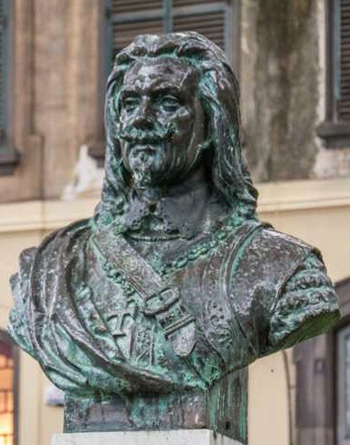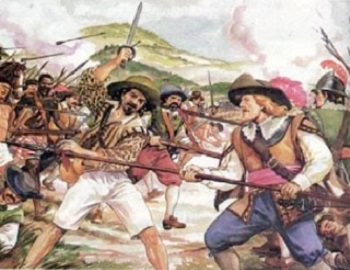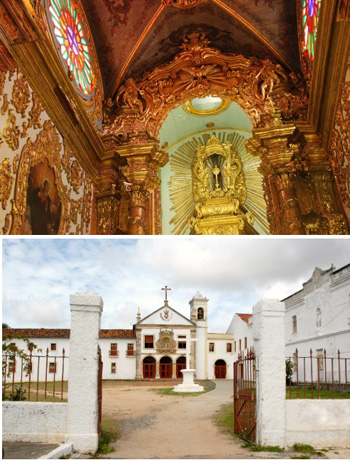World History
 |
 |
 |
 |
 |
 |
 |
Brazilian Catholics Miraculously
Defeat the Dutch Protestants
This is the story of the beautiful miracle wrought through Our Lady’s intercession during the Pernambucan Insurrection in the Battle of Monte das Tabocas, which was part of the Lusitanian-Dutch War of the 17th century. The battle took place in Monte das Tabocas, in the city of Vitoria de Santo Antão, Pernambuco, Brazil.
The city’s name translates to “Victory of St. Anthony,” for the city took its name from the miraculous appearance in the battle of St. Anthony the Great (also known as St. Anthony of the Desert, who met with St. Paul the Hermit). Local government officials agreed on this name for their city to give homage to the Saint who ensured the Catholic victory at the Battle of Monte das Tabocas (which translates to the Mountain of Tabocas). Taboca is the local name for a type of bamboo plant native to Brazil.
Since that time, there has been a lively devotion to Our Lady of Tabocas.
The city’s name translates to “Victory of St. Anthony,” for the city took its name from the miraculous appearance in the battle of St. Anthony the Great (also known as St. Anthony of the Desert, who met with St. Paul the Hermit). Local government officials agreed on this name for their city to give homage to the Saint who ensured the Catholic victory at the Battle of Monte das Tabocas (which translates to the Mountain of Tabocas). Taboca is the local name for a type of bamboo plant native to Brazil.
Since that time, there has been a lively devotion to Our Lady of Tabocas.
In the 17th century, after their defeat in an attempt to conquer Bahia, the Dutch set their sights on Pernambuco. In 1630 Recife was dominated by the Dutch Batavians, and for 15 years, the invaders had been advancing through the lands of Pernambuco.
This was not just a dispute between nations, for what most differentiated the Portuguese-Brazilians from the Dutch was their faith. While Portugal had deeply planted the teachings of the Holy Catholic Church in the Brazilian soil, the Dutch, on the contrary, wanted to impose Protestantism in its most odious form against Catholicism. Therefore, wherever the invaders passed, terrible massacres occurred of the Brazilian population of Pernambuco who remained faithful to Holy Mary.

Commander João Fernandes Vieira
A few months earlier, João Fernandes Vieira, commander of the Brazilian troops, had gathered together the men willing to fight in the city of São Lourenço. As the Dutch Batavians approached, João Vieira took his entire contingent to a strategic hill covered with bamboo called taboca, about 30 miles from Recife.
To put a hasty finish to this dangerous insurrection, the Dutch sent a large contingent under the command of Captain Hendrick Van Haus. It was on the 2nd of August that Van Haus reached the edge of the taboca hill where the Catholic soldiers had gathered. For the Dutch, victory seemed certain and simple, for they had 1,500 armed soldiers and numerous allied Indians. Although Vieira had about a thousand men, only 230 of them had firearms.
In an impassioned speech before the battle, Captain Vieira addressed his soldiers recalling that “he who has God on his side cannot doubt the victory." "And we know," he continued, "that we fight against a people who openly offend God. The broken sacred images, the stones of destroyed temples, the bodies of Catholics torn to pieces, the mocking offenses against priests - what is all this but weapons that Heaven gives us to destroy these heretics?”

Brazilians fighting the Dutch
While fighting, Fathers Simon de Figueiredo, João de Araújo and the Benedictine Friar João da Resurreição [John of the Resurrection] fearlessly moved through the Catholic ranks, confessing and blessing the Brazilian soldiers. Father Manuel de Morais held high a banner with an image of Jesus Crucified, and urged the soldiers to fight manfully and to make their promises to Our Lord and the Blessed Virgin.
Everyone felt endowed with a truly supernatural courage, willing to fight to the death in defense of the Catholic Faith. The soldiers promised penance and good works; the commander vowed to build a church in honor of Nossa Senhora do Desterro [Our Lady of Exile] and another in honor of Nossa Senhora de Nazaré [Our Lady of Nazareth].
Unnerved by such ardor, the Dutch reaction had no choice but to intensify the attack, and thus managed to regain the advantage in the battle. Then João Vieira shouted: “Valorous Portuguese, long live the Faith of Christ! Forward! Forward!" His words were followed by those of Father Manuel who urged everyone to pray together a Salve Regina.

Our Lady of the Exile Church built by Commander Vieira in gratitude for her help in the battle
There is no doubt that this Woman was the Blessed Virgin with her Divine Son. Before this last attack, the Pernambucans' ammunition was already reaching its end. However, after the battle it was found that, despite the unrestricted use of bullets, there miraculously remained still more in their stocks.
As for the hermit, he was none other than St. Anthony the Great, or St. Anthony of the Desert, popularly known as Santo Antão. There had been a chapel dedicated to him nearby, but it had been destroyed and abandoned since the invasion of the Dutch heretics.
In gratitude and to fulfill his promise, João Fernandes Vieira had a church built in honor of the Virgin at the entrance to Olinda.
Our Lady of Tabocas, pray for us!
Original here

Posted January 22, 2024
______________________
______________________





